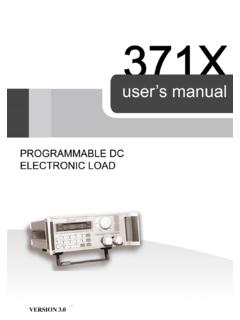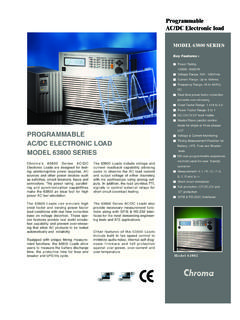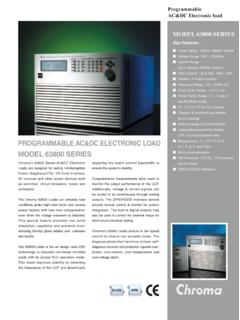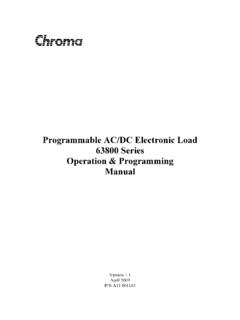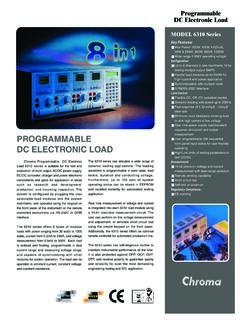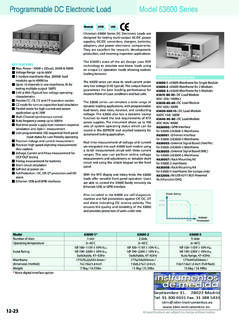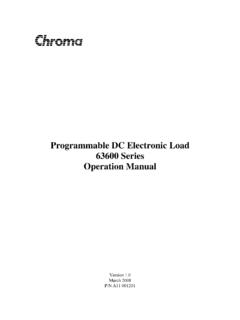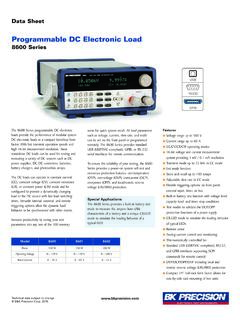Transcription of AN133 - A Closed-Loop, Wideband, 100A Active Load
1 Application Note 133AN133-1an133fOctober 2011A Closed-Loop, Wideband, 100A Active LoadBrute Force Marries Controlled Speed Jim WilliamsNote 1: See Reference 1, from which the immediately following material partially derives, for details and descriptions of very wideband load transient generators, albeit at much lower currents. L, LT, LTC, LTM, Linear Technology and the Linear logo are registered trademarks of Linear Technology Corporation. All other trademarks are the property of their respective systems, particularly microprocessors, furnish transient loads in the 100A range that a voltage regulator must service.
2 Ideally, regulator output is invariant during a load transient. In practice, some variation is encountered and becomes problematic if allowable operating voltage tolerances are exceeded. 100A load steps, characteristic of microprocessors, exacerbate this issue, necessitating testing the regulator and associated components under such transient loading conditions. To meet this need, a closed-loop, 500kHz bandwidth, linearly responding, 100A capacity Active load is described below. Study of this approach is prefixed by a brief review of con-ventional test load types and noting their load Transient GeneratorFigure 1 diagrams a conceptual load transient generator.
3 The regulator under test drives DC and switched resistive loads, which may be variable. The switched current and output voltage are monitored, permitting comparison of the nominally stable output voltage versus load current under static and dynamic conditions. The switched current is either on or off; there is no controllable linear region. Figure 2 develops the concept by including electronic load switch control. Operation is straightforward. The input pulse switches the FET via a drive stage, generating a transient load current out of the regulator and its output capacitors.
4 The size, composition and location of these capacitors has a pronounced effect on transient response and must be quite carefully considered. Although the electronic control facilitates high speed switching, the architecture cannot emulate loads between the minimum LOADSWITCHCURRENTMONITORAN133 F01 RSWITCHED LOADDC LOADREGULATORUNDER TESTREGULATORINPUT SUPPLY+EREGULATORRSWITCHED LOADEREGULATOR ISWITCHED = AN133 F02 RSWITCHEDLOADISWITCHEDMONITORREGULATOR UNDER TEST,INCLUDING OUTPUT CAPACITORS+ Figure 2.
5 Conceptual FET Based load Tester Permits Input Pulse Controlled Step Loading. As Before, Switched Current Is Either On or Off; There Is No Controllable Linear RegionFigure 1. Conceptual Regulator load Tester Includes Switched and DC Loads and Voltage/Current Monitors. Resistor Values Set DC and Switched load Currents. Switched Current Is Either On or Off; There Is No Controllable Linear RegionApplication Note 133AN133-2an133fand maximum currents. Additionally, FET switching speed is uncontrolled, introducing wideband harmonic into the measurement, potentially corrupting the oscilloscope display.
6 Closed-Loop load Transient GeneratorPlacing Q1 within a feedback loop allows true, linear control of the load tester. Figure 3 s conceptual closed-loop load transient generator linearly controls Q1 s gate voltage to set instantaneous transient current at any desired point, allowing simulation of nearly any load profile. Feedback from Q1 s source to the A1 control amplifier closes a loop around Q1, stabilizing its operating point. Q1 s current assumes a value dependent on the instantaneous input control voltage and the current sense resistor over a very wide bandwidth.
7 Note that once A1 is biased to Q1 s con-duction threshold (by the dc load Set ), small variations in A1 s output result in large Q1 channel current changes. As such, large output excursions are not required from A1; its small signal bandwidth is the fundamental speed limitation. Within this restriction, Q1 s current waveform is identically shaped to A1 s input control voltage, allow-ing linear control of load current. This versatile capability permits a wide variety of simulated loads. Figure 4 further develops Figure 3, adding new elements.
8 A gate drive stage isolates the control amplifier from Q1 s gate capacitance, maintaining amplifier phase margin and providing low delay, linear current gain. An X10 dif-ferential amplifier provides high resolution sensing across the 1m current shunt. The dissipation limiter, acting on the averaged input value and Q1 temperature, shuts down gate drive to preclude excessive FET heating and subsequent destruction. Amplifier associated capacitors tailor bandwidth and optimize loop response.
9 INPUTPULSE(NEGATIVE) Q1AN133 F03 ISWITCHEDAND DC LOADMONITOR100A REGULATOR UNDER TEST,INCLUDING OUTPUT CAPACITORS+ +BASELINE/ dc load SET VA1 + AN133 F04 TEMPSENSEFET TEMPINPUT AVGREGULATOR UNDER TEST,INCLUDING OUTPUT CAPACITORSDISSIPATION LIMITER+ +SHUTDOWNA1 GATEDRIVESTAGEINPUTPULSE(NEGATIVE)X10 VBASELINE/ dc load SETF igure 3. Feedback Controlled load Step Tester Allows Continuous FET Conductivity Control. Input Accommodates Separate DC and Pulsed Loading InstructionsFigure 4. Developed Form of Figure 3. Differential Amplifier Provides High Resolution Sensing Across Milliohm Shunt.
10 Dissipation Limiter, Acting on Average Input Value and FET Temperature, Shuts Down Gate Drive, Precluding Excessive FET Heating. Amplifier Associated Capacitors Tailor Bandwidth, Optimize Loop ResponseApplication Note 133AN133-3an133fDetailed Circuitry DiscussionFigure 5 s detailed schematic of the 100A capacity load tester follows Figure 4 s outline. A1, responding to DC and pulse inputs and current indicating feedback from A3, sets Q1 s conductivity via the actively biased Q4-Q5 gate drive stage. A2 determines stage bias under all conditions by comparing Q5 s averaged collector voltage to a reference and controlling Q3 s conduction, closing a loop.










